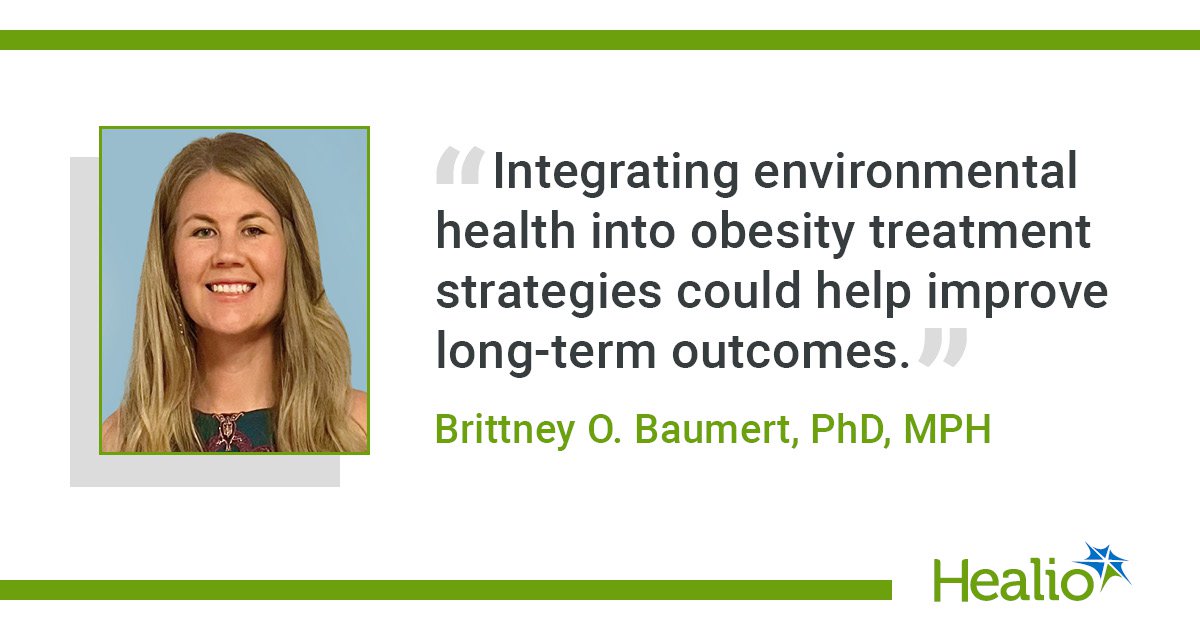August 19, 2025
3 min read
Key takeaways:
- Higher presurgical plasma levels of three types of PFAS were tied to greater weight regain for teens after bariatric surgery
- More research is needed to assess the impact of PFAS on other obesity interventions.
Adolescents who undergo bariatric surgery regain more weight after surgery if they are exposed to higher levels of per- and polyfluoroalkyl substances, according to study findings published in Obesity.
In an analysis of data from the Teen-LABS study, which assessed bariatric surgery outcomes among adolescents aged 19 years and younger, patients who had higher plasma concentrations of three types of perfluoroalkyl sulfonic acids had greater BMI, weight and waist circumference regain 1 to 5 years after surgery.

“Given the increasing use of weight-loss interventions to treat obesity, these findings highlight the need to address environmental factors alongside clinical care,” Brittney O. Baumert, PhD, MPH, a postdoctoral research fellow in the department of population and public health sciences at the Keck School of Medicine of University of Southern California, told Healio. “Integrating environmental health into obesity treatment strategies could help improve long-term outcomes.”
The study included 186 adolescents who underwent Roux-en-Y gastric bypass or sleeve gastrectomy from 2007 to 2012 (mean age, 17.1 years; 76.3% female). PFAS were measured through fasting blood samples obtained 30 days before surgery. BMI, body weight and waist circumference were collected 6 months and 1, 3 and 5 years after surgery.
PFAS tied to postsurgical outcomes
The study group had a mean weight loss of 30.5% at 1 year compared with before surgery. At 5 years, mean weight loss was 23.5%.
Adolescents exposed to 2.73 ng/mL perfluorooctane sulfonate (PFOS) had a 1.34 kg/m2 BMI regain per year. Those exposed to 0.9 ng/mL perfluorohexane sulfonic acid (PFHxS) had an annual BMI regain of 1.33 kg/m2. Exposure to 0.1 ng/mL perfluoroheptanesulfonic acid (PFHpS) was tied to a 1.29 kg/m2 annual BMI regain. The interaction between PFAS concentration and BMI change was statistically significant for PFOS (beta for interaction = 1.38; P = .0497), PFHxS (beta for interaction = 1.04; P = .036) and PFHpS (beta for interaction = 2.39; P = .017).
Findings were similar for percentage of body weight loss. Exposure to 2.73 ng/mL PFOS was tied to a 2.73 percentage point increase of body weight per year (beta for interaction = 2.54; P = .04). Exposure to 0.1 ng/mL PFHpS was associated with a 2.59 percentage point rise in body weight annually (beta for interaction = 2.86; P = .018). Adolescents in the highest tertile for PFHpS exposure had a weight regain of 4.31 percentage points per year vs. a 2.68 percentage point weight regain for those in the lowest tertile.
A plasma level of 0.9 ng/mL of PFHxS was associated with a 0.29 cm increase in waist circumference per year. Additionally, adolescents in the highest tertile for PFHpS level had a 2.74 cm increase in waist circumference each year compared with a 0.29 cm increase for those in the lowest tertile.
When combined mixture effects of PFOS, PFHxS and PFHpS were assessed, each one-quartile increase in mixture was tied to a 4.41 cm rise in waist circumference 5 years after surgery (P = .041). PFAS mixture was not significantly associated with change in BMI and weight loss at 5 years.
More research needed
Baumert said the study’s findings were novel, allowing researchers to assess the impact of PFAS exposure on body weight among adolescents and to ascertain its impact on bariatric surgery outcomes.
“These findings add a new dimension to PFAS research, suggesting that these chemicals may influence not only the development of obesity, but also the long-term success of obesity treatment in youth,” Baumert said.
Beyond policy level changes, Baumert said individuals can take action to reduce PFAS exposure by replacing nonstick cookware with PFAS-free alternatives, using a filter to remove PFAS from drinking water and carefully reading product labels to avoid using items containing PFAS and similar chemicals.
Future research should continue assessing the impact PFAS has on weight outcomes, including on people using obesity medications, Baumert said, noting the mechanisms that cause PFAS to affect body weight need to be determined.
“Integrating environmental biomarker screening into long-term weight-loss intervention clinical trials could help tailor follow-up care and counseling to further support long-term weight loss and metabolic health in youth,” Baumert said.
For more information:
Brittney O. Baumert, PhD, MPH, can be reached at bbaumert@usc.edu, on Instagram @brittneybaumertphd or on LinkedIn @BrittneyOliviaBaumert.










